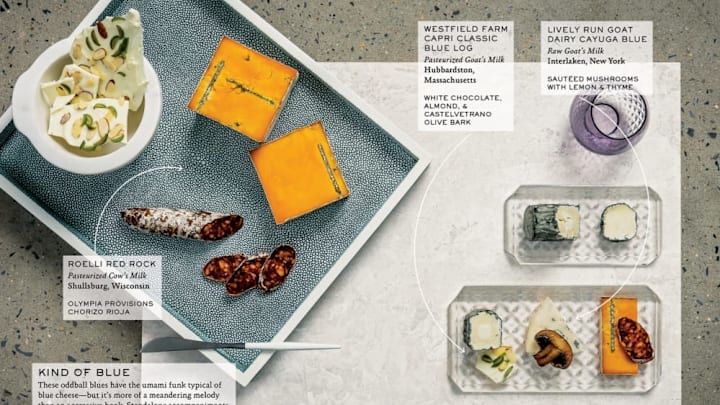A new book will help you take your appetizer game to the next level.
To know cheese is to love cheese. But just because you order the cheese plate at every farm-to-table restaurant you visit doesn’t mean you know how to put together something more sophisticated than a platter of cheddar cubes.
In The Art of the Cheese Plate, chef and cheese specialist Tia Keenan takes you through the theory and practice of creating the cheese plate, from how to choose which cheeses to highlight to what makes a good accompaniment. While she includes many recipes, the book also encourages you to branch out, mixing and matching your own cheeses and pairings based on your newly acquired knowledge.
Keenan promises that it’s not as hard as it sounds. “Seriously, you’d have to really try to ruin a cheese plate,” she writes. But for the amateur cheese lover, here are a few spreads to get you started:
There are Mark Twain fans, and then there’s Kevin MacDonnell. The rare bookstore proprietor and independent scholar lives in Austin, Texas, where he maintains one of the world’s largest (if not the largest) private collections of Twain artifacts. Over the past few decades, MacDonnell has amassed over 8000 items—including first editions, personal letters, manuscripts, and items owned by Twain himself—along with 1500 historic ads, souvenirs, and promotional items related to the author’s career.
Why build a scholarly shrine to Twain instead of, say, Ernest Hemingway or Charles Dickens? “I was always attracted to his works,” says MacDonnell, who purchased his first Twain work at the age of 15 in 1968. “People view Twain as just as a humorist, but he’s much more than that," he tells Mental Floss. "He comments on politics, human nature, religion, race relations … He had opinions on everything going on during his time.”
Topics like these are still socially charged, MacDonnell says, making Twain’s writing just as relevant today as it once was during the 19th century. Plus, he adds, Twain was equal parts marquee personality and sideline critic, a dualism that makes him unique among authors.
"He wasn’t just a literary artist—he was also a social icon," MacDonnell says. "He had a certain amount of celebrity. People knew the name. They knew what he looked like [and] they thought they knew who he was and what he thought about things, even if they had never read anything that he had ever written.”
MacDonnell safeguards his Twain collection in a climate-controlled home archive, which he opens up to the occasional researcher or bookseller. Here, the collector provides literature lovers with a virtual peek inside his holdings.
1. BLUE CHEESES

“A successful pairing achieves balance between the cheese and the accompaniment,” Keenan advises. “If one is more charismatic or dominant than the other, the pairing feels off. The saddest pairing is one that leaves you wishing you'd eaten the cheese on its own.”
On this plate, she recommends pairing three blue cheeses—a chévre log, a goat cheese, and a Wisconsin cheddar—with white chocolate almond bark, chorizo, and sauteed mushrooms. (Any cheese can become a blue cheese if the mold penicillium is added to the milk during production.)
2. CHÉVRE

Many recipes for cheese pairings incorporate acidity in some way. “Whether via citrus, vinegar, or wine, acidity is a counterpoint to butterfat," according to Keenan. "It cuts through cheese, invigorating the sense and combating palate fatigue. It brightens other flavors and makes shy ingredients shine.”
Here, the matcha marshmallows she suggests have a mild acidity that can pair with the Valençay’s citrus tones. The spiced cashews, on the other hand, can help offset the potentially overwhelming acidity of the Bücheron cheese.
In this spread, she also suggests pairing lychee with Chabichou because the floral undertones of the fruit will bring out the same in the cheese, and “its silky texture plays well against the cheese’s rich paste.” This interplay of two textures is vital for cheese pairings, since, as she notes, a "light/mild/fluffy cheese and a dense/robust/hard accompaniment will rarely find balance together."
3. STINKY CHEESES

“When all elements of a cheese plate and its accompaniment are in harmony, you find what’s often referred to as the ‘third taste,'” Kennan writes. "This is where the magic happens, when two different flavors come together to create a third flavor, distinct from and greater than the sum of its parts. It doesn’t taste like the cheese or like the accompaniment. It taste like the pairing, completely and singularly unique.”
The red onion, dill, and vinegar with pumpernickel bread crumbs Keenan suggests as pairings for Red Hawk cheese creates this third taste—“a crave-worthy sour, sweet, and funky bite that boasts both a light freshness and a deep richness,” as Keenan describes it.
4. MIXED MILKS

The cheeses Keenan chose for her “mixed milk” plate all have pasteurized cow's milk mixed with either goat or sheep's milk, and the accompaniments she suggests are meant to either support or contrast the cheese’s flavor. The sweet and sour notes of the wild hibiscus flowers in syrup contrast the tripe-creme richness of Kunik cheese, while the candied jalepeños help pick up some of the sweet and spicy flavors in the Valdeon cheese.

While these pairings and the recipes included in the book can get you started, they aren't the only ways to enjoy cheese. “The answer to 'Does this pairing work?’ is ‘Did you like it?’” Keenan writes. “In fact, there is no ‘perfect pairing’; the very concept eliminates the truly personal and experiential nature of eating.”
The Art of the Cheese Plate is $19 on Amazon.
All images © Noah Fecks, from The Art of the Cheese Plate by Tia Keenan, Rizzoli New York, 2016
